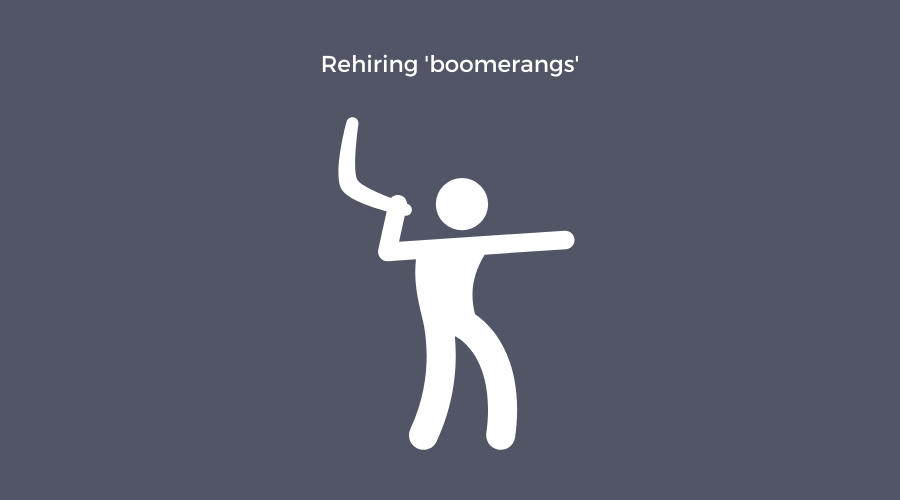
Make Employee Rehiring Part of Your Talent Strategy
As vaccination rates rise and the COVID pandemic begins to subside, companies looking to restaff are discovering hiring more of a challenge than they suspected. But rehiring former employees may prove to be an untapped resource.
Just this month, the CEO of restaurant franchiser FAT Brands described finding workers as a “total nightmare.” The National Federation of Independent Businesses said 42% of the small businesses it surveyed said they have jobs they can’t fill.
With 8 million fewer people in the workforce and an unemployment rate declining each month, employers are turning to a strategy many of the largest companies adopted years ago – rehiring former workers.
They learned long ago that staying in touch with former employees – company alumni (sometimes referred to as boomerangs)– has all sorts of benefits, besides simple goodwill. One of the most valuable is that it gives the company a ready pool of talent recruiters can tap for referrals and rehires.
When companies began opening up after the shutdown rules loosened, they first recalled workers they laid off. Now, as hiring becomes ever more difficult, employers are reaching out to former employees who left for other jobs even before the pandemic shutdown.
The Benefits of Rehiring Employees
Old policies against rehiring former workers have given way to the reality that the skills and experience they bring far outweigh dated notions of loyalty. These rehires – often called “boomerangs” — need far less training and time to get up to speed compared to a first time hire. Rehires are also cheaper and faster to bring on board.
Besides those obvious advantages, a rehire is a known quantity. Their former manager can attest to their skills and their fit both on the team and with the company culture. Performance reviews provide a record of the rehire candidate’s work and productivity.
Rehires “understand the company, the product, the services, the systems and what’s expected of them,” said the chief people officer for Kronos, an HR tech provider.
“You also know that the boomerang will mesh with the culture, which can’t be understated.”
Rehires also offer some less obvious advantages. During their time away from the company they learned new skills and improved existing ones. Their return may also give colleagues second thoughts about leaving.
Pete Sosnowski, VP of People at Zety, says rehires benefit from the experience working for a different company, whether in the same or different industry. “When they come back after a few years, they bring new experiences, contacts, customers, or at least a fresh point of view.”
The most famous rehire in recent history is Steve Jobs. Fired in 1985 from Apple, the company he co-founded, he was brought back as CEO in 1997 to save the company and build it into a global leader.
Rehiring Issues to Consider
Of course not all rehires turn out as successfully, so before rehiring a company alum you need to apply the same due diligence you would to any candidate. Their HR record is an open book, yet it’s important to learn all you can about what they’ve been doing since leaving the company.
Here are some of the reasons even a previously stellar performer might not make a good rehire:
- The company changed in ways the rehire may resist.
- The worker may have changed in ways no longer compatible with the company or team culture.
- There may be unresolved personality issues with former colleagues.
- The rehire might expect to be accorded more privileges or benefits based on their previous years of service.
- Hiring them into a more senior position may affect morale. This is especially critical if the job is one others on the team wanted.
- There’s also the risk that having left once, they may do it again.
How to Successfully Rehire
While the first place to start is with company records, no matter how good a rehire candidate’s track record, don’t shortcut the hiring process. All candidates need to be treated the same.
The interview is the place to probe not just for what they’ve learned and the experience they’ve gained, but also for personality issues.
Review their exit interview to understand why the employee left the company. If they expressed dissatisfaction with a manager or situation or policies, these are red flags to explore with the candidate. Rehires who left for more pay or to take a promotion may become resentful if they have to take a step back.
Hiring managers should also get input from their team. Encourage frankness. You want to identify any issues before making an offer.
When you do rehire, don’t skip onboarding. Especially since the COVID crisis new procedures and ways work gets done – remote work, for example – have likely replaced the policies of the past. Even the most enthusiastic and talented rehire will need to be brought up to date and given time to adjust.
It’s encouraging to know that studies show three-quarters of managers who have made a rehire are glad they did. A ZenBusiness survey found almost 6-in-10 managers would rather rehire than bring in an equally qualified new worker.
That’s a good enough reason for every company to stay in touch with former employees. These groups of alumni not only can serve as ambassadors promoting the company and its products and services, but are a rich source of referrals and rehires.
It costs little to start a group, yet the dividends are great.
###
John Zappe contributed to this article.


